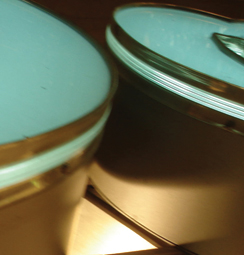Some fabrication staples in the sign industry have shifted thanks to advances in technology, however fundamentals (like the channel in channel letters) remain a basic constant.
So what does one have to add to this sign piece, in order to give it a different, standout design?
The answers rest in looking at what’s actually “across the channel.”
Tradition
Let’s talk about tradition. Channel letters were long metal-fabricated, so as to house the electrical components, the power connections, and the lighting—all the while being able to do so in the form of a recognizable font or shape.
Based on its simplicity, sheet metal has acted as the foundation of the letter for quite some time now. Because of this, any-size sign shop is able to cut-to-fit and/or paint-to-match with good results.
Meanwhile neon has been the traditional lighting component used for channel letters. Reasons for its popularity include flexibility and longevity (the latter of which should be sufficient cause alone).
But another advantage is the rainbow of colors that are available with neon. (Note: The key to creating successful electric letters is being able to capture the actual look of the desired illuminated color.)
Confined within the perimeter of the channel, neon glows with defined visibility beyond mere front-lit signage lettering. In the “classic” mode, you’ll find neon exposed (no face) in its channel letter presentation. This makes it excel as a visual part of the sign—and not just merely an illumination method.
However the open-face neon tube look can lead to worries of birds, pests, rain, and/or dirt getting into the channels. If you (or your customers) feel the same way, clear faces have become a common fix.

Opaque Cover
In recent years, some face materials have evolved beyond just a choice for color; instead they’ve become an integral electrical component in a Listed channel letter (for example, using the required plastic material in an easy-to-stock white with a film-first surface).
Does your client have a specific, preferred acrylic color in mind for the face? If so, the key is what goes across the channel—and this can involve CNC cutting, trim cap, adhesive, screws, etc.
While acrylic has a long life in the elements, the need for color may trump its usage, which means taking a serious look at plastics. The uniqueness of the plastic face (or combination of different materials) creates an otherworldly glow that exposes the neon tube outline and ensures a nice design.
You can even consider possibly using opaque plastic to hide the illumination—but not completely. This effect in a large set of letters will create a bright, illuminated line along the perimeter. (Note: And with clean lines, the light source specifics you employ may be irrelevant.)
If you’re a shop with no in-house tube bender but with access to computer cutting, then CNC routers can make short work of creating the perimeter line (compared to having to create the neon).
But if you think there’s a limit to where “squirt gun” plastic colors work, then consider that covering an illuminated channel letter turns the choice of stock plastic into a working palette of colors. If this is a limitation, use white or clear faces (with transparent film applied first surface). This may create a very different look, as well as provide a wider variety of color combinations. (Note: Be aware that close viewing distance is a plus for this style of channel letter.)
New Age
Today’s range of vinyl films has really opened up a host of design possibilities to those sign companies making channel letters.
Several years back, long-life, uniform color vinyls were introduced to the market. This availability provided a means for anyone to be able to create repetitious quality at a known cost.
The possibilities are still very new for using these vinyl materials to differentiate one’s channel letters. Mixing plastic with vinyl colors (especially transparent films) produces a unique rainbow of colors and evolving patterns.
And the advent of lower cost digital printers into the signage mix opens the door to allow one to replace stock colors with custom colors. In fact, these hardware vendors that make their own printed vinyl colors to ensure a perfect color match opens up the ability for you to create a look and feel for the channel letter face beyond the solid-color acrylic traditionally used in channel letters (and far beyond overlaid cut-vinyl).

Sure it’s not a new feat, but it is another case of technology bringing talent to the masses. Past lives would’ve found the graphics shop cutting shapes and/or layers of a stylized design to be able to create such a varied image. Now there’s no need to make it—only fake it.
Just Go Crazy
One piece of advice: When contemplating what goes across the face of your next set of channel letters, go crazy.
One simple, interesting trick to use with a blue acrylic face is “stacking” layers of plastic over it. This will add dimension, as well as an edge-lit glow.
Then consider little lights. These are much less complicated to produce with modern CNC technology than the signs found on the original Great White Way. So look for the newer RGB LED strings that are available. It’s a combination of interesting illumination technology with an updated, controllable look.
Lastly full acrylic letters (a staple in some European cities) have a 3D shape in the daytime, as well as when illuminated. Besides this, they come with a vibrant transparent color. (Hey, look, another use for those “squirt gun”-colored plastics!)
By Peter Perszyk
All photos: Peter Perszyk.











